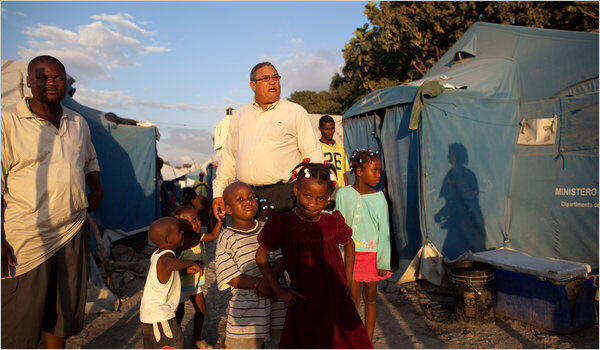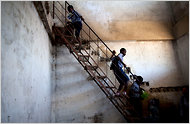PORT-AU-PRINCE, Haiti — The remains of the cells at Fort Dimanche, where political prisoners were once crowded in their own excrement, are now being used as a school, though without electricity or running water, much less books.
In Haiti, Duvalier Reopens Old Wounds
 |
|
ELIANA APONTE TOBAR FOR THE NEW YORK TIMES |
| Robert Duval, a soccer coach who was imprisoned during the era of Jean-Claude Duvalier, is one of the few who have brought charges against him. |
By GINGER THOMPSON
Related
-
Times Topics: Jean-Claude Duvalier | Haiti
 |
|
ELIANA APONTE TOBAR FOR THE NEW YORK TIMES |
| Jean-claude Duvalier, right, the ex-dictator knowm as Baby Doc, listened to a translator during a meeting. |
Women sell mud cakes — a staple for the many Haitians who cannot afford to fill their bellies any other way — on the pavement out front, where detainees were forced to stand naked under the scorching sun until they collapsed.
And in the field where guards once dumped prisoners who had been hacked and beaten to death, the families of a nearby slum now bury their own loved ones.
The havoc that Jean-Claude Duvalier, the former dictator known as Baby Doc, wrought on this country has never been overcome. Old misery is simply layered over by new misery.
Whatever infrastructure had not succumbed to neglect in the 25 years since riots forced Mr. Duvalier to flee was destroyed by last year’s earthquake. Much of the nation’s focus has shifted to surviving newer tragedies, like cholera and mass homelessness.
Still, there has been a deafening silence among those who intimately remember places like Fort Dimanche: the number of the cell where they were held, the way they ate grits off the floor. In the two weeks since Mr. Duvalier’s surprise return from exile, only a handful of the tens of thousands of people who human rights groups say were illegally detained and tortured by his regime have come forward to press charges.
To Mr. Duvalier, the fact that so few people are clamoring against him is proof that this country is ready to move forward, a process he claims he wants to help.
“Haiti is in my blood,” Mr. Duvalier said in a brief meeting with The New York Times on Monday. “I cannot be indifferent to its suffering.”
But those who have brought charges against him — a journalist, a doctor, an agronomist, a historian and a soccer coach — worry that the absence of an uproar shows that Haitians are still afraid.
“That’s the strength of the stigma that Duvalier left on this country,” said Robert Duval, a soccer coach who spent 17 months in Mr. Duvalier’s dungeons until he was released in 1977, after the Carter administration intervened on his behalf and on that of 105 other prisoners. “He may not have been on our minds, but now that he’s back, we see that the fear of him is still in our hearts.” He added, “I struggle against it every day.”
A bear of a man whose voice rises to a growl, Mr. Duval does not seem easily flustered. Yet now that he is again sharing the same streets with Mr. Duvalier, who faces charges of corruption and crimes against humanity but is not being detained, he is tense and experiences radical mood swings. At one moment Mr. Duval riffed triumphantly about finally seeking charges against the ousted leader. And then, he suddenly collapsed into heaving sobs over the effect his time as a political prisoner had on his mother.
Mr. Duval said he lost more than half his weight and a little of his humanity as he watched 180 people die in cell No. 10 at Fort Dimanche. The cell, he said, was 13 feet by 14 feet. It held as many as 40 men at a time.
“I counted the ones who died, because usually it meant more space to sleep for the rest of us,” he said. “And sometimes we didn’t tell the guards a person died until their body started to stink because we wanted the extra food.”
The son of a businessman, Mr. Duval still does not know why he was detained. He said that he had just returned to Haiti from studying business in Canada, and that he was helping his father run a tire retread factory.
At the end of 1975, a soldier dressed in civilian clothes and sunglasses arrived to say that military officials wanted to see him. Mr. Duval had known the soldier since childhood, so he was not afraid, until he got in the back seat of the officer’s car and found two other officers with guns in their laps.
“I thought it was all a joke until they sent me to Fort Dimanche.”
Alix Fils-Aimé, an agronomist, had the same sinking feeling when he was hauled off to Fort Dimanche in April 1976. He said he was helping organize farmers in the northeast when he was detained by men in military uniforms and others in the dark blue pants and shirts worn by Mr. Duvalier’s feared militia, known as the Tontons Macoutes, Creole for boogeymen.
Mr. Fils-Aimé said he spent much of his time in solitary confinement in a windowless cell the size of a closet, with a narrow opening where guards passed him occasional handfuls of rice. He went without seeing light for weeks, and the only voices he heard were screams from other prisoners.
“Sometimes guards would open the door and ask my name,” Mr. Fils-Aimé recalled. “I told them, ‘What am I doing here if you don’t even know my name?’ ”
Human rights advocates hope to get answers to that and other questions if Mr. Duvalier is taken to court on charges of corruption, embezzlement, illegal detention and torture. The former dictator has surrounded himself with lawyers, including three Americans led by former Representative Bob Barr of Georgia. And he is holed up in a mountainside estate named the Château Phoenix, making clear he is not ready to give many answers.
The former “President for Life,” as Mr. Duvalier was known, made a brief, boilerplate comment last week about returning to help Haiti rebuild after last January’s earthquake.
But when asked to explain why he had decided to help now, considering Haiti’s many needs during the years he enjoyed a lavish exile in France, Mr. Duvalier’s lawyers interrupted; his chain-smoking companion, Véronique Roy, tapped his shoulder to say he had been urgently called to attend a friend’s funeral, then escorted Mr. Duvalier away.
Michèle Montas, who helped run one of this country’s most important radio stations during the late 1970s, says she has both covered Mr. Duvalier and been terrorized by him. In a crackdown against Mr. Duvalier’s opponents on Nov. 28, 1980, she and dozens of other journalists, academics, union organizers and activists were rounded up and jailed. She considers herself one of the lucky ones who were released and deported. Several others, she said, were brutalized to death.
“The country fell silent for years after that day,” said Ms. Montas, a former spokeswoman for United Nations Secretary General Ban Ki-moon, and another plaintiff against Mr. Duvalier. “We were just beginning to recover from that, and now Duvalier has returned, threatening to put the country back where he left it 25 years ago.”
She added, “We’re not going to let that happen.”
A few days after Mr. Duvalier’s return, the government charged him with corruption — mostly involving an estimated $300 million that Mr. Duvalier is accused of looting from Haiti’s treasury — and crimes against humanity. Ms. Montas and four others came forward to press separate charges in the days after, and urged others to do the same.
Even though Mr. Duvalier appears older and more fragile, his myth remains powerful. And with close friends and former colleagues involved in the campaigns of all three of this country’s leading presidential candidates, it is clear that powerful parts of Mr. Duvalier’s network are intact.
Others who have refused to press charges said they lacked faith that they could get justice in Haiti.
“There is no doubt that Duvalier should be tried,” said one former senior justice ministry official who asked not to be named because he still has professional dealings with officials involved in the case. “The question is whether there is the will.”
Students at the La Saline Education Village, built on the ruins of Fort Dimanche, took a break from their grammar lesson to talk about Mr. Duvalier’s rule. Some students said they were aware that their school was once a prison camp, and talked in vague, albeit graphic, terms about prisoners being brought here but not leaving alive.
But most seemed to have little patience for the past. The killings at Fort Dimanche might have been tragic, they said, but what bothered them more were the gangs who gunned down people in the slum that has been built in the old prison camp’s shadow.
“My father told me that when Duvalier was here, it was easy to find food,” said Verginho Rejiste, a lanky 15-year-old. “And if you crossed him, he used the baton.”
Elcide Geodol, 19, jumped up from her seat. “It’s true that Duvalier used the club to push a political agenda,” she said. “But now we have gangs killing people, and we don’t know why.”


